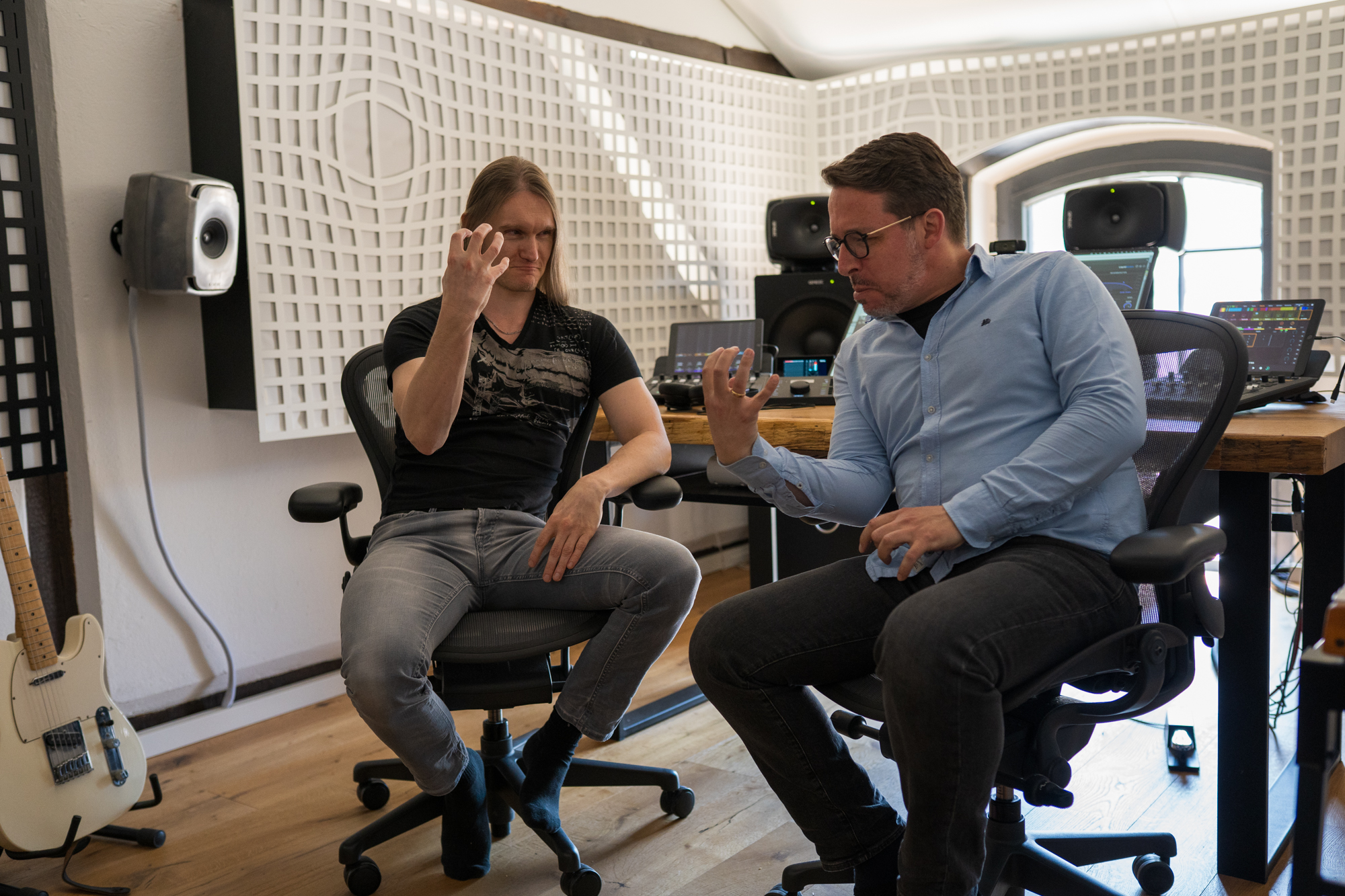
In part one of our interview, Eric Horstmann shared the technical foundations of his pioneering work in immersive audio – from his film post-production roots to building a successful career in Dolby Atmos music mixing at his own Immersive Lab. We explored his object-based Pro Tools workflow, his strategic use of LiquidSonics reverbs, and his philosophy that immersive mixing should tell a compelling story rather than just representing technical novelty and gimmickry.
Now, in this second instalment, Eric takes us into uncharted territory: mixing extreme metal in Dolby Atmos. When fretless-guitarist / composer / producer Tom Fountainhead approached him about his progressive death metal project Changeling, Eric saw an opportunity to challenge both himself and the industry’s preconceptions about what genres belong in immersive formats. The result was a groundbreaking 60-minute album co-mixed by Eric and Tom featuring a 50-piece orchestra that transforms metal’s traditional “wall of sound” into what Eric and Tom call a “room of sound.” Together, the pair worked in close collaboration, with Eric providing technical expertise and a big-picture mindset, while Tom ensured that every detail of his production and compositional storytelling was perfectly represented in the immersive space.
What follows is a masterclass in creative problem-solving, as Eric reveals how they tackled the unique challenges of preserving punch in an immersive mix, how strategic placement replaced surgical EQ in creating clarity within dense metal arrangements, and why there was no reason to look beyond the LiquidSonics plugins in Eric’s template for reverb.
For engineers considering immersive mixing, especially those working in heavier genres, these insights offer both practical techniques and creative guidance on pushing the boundaries of what is possible in immersive music mixing.
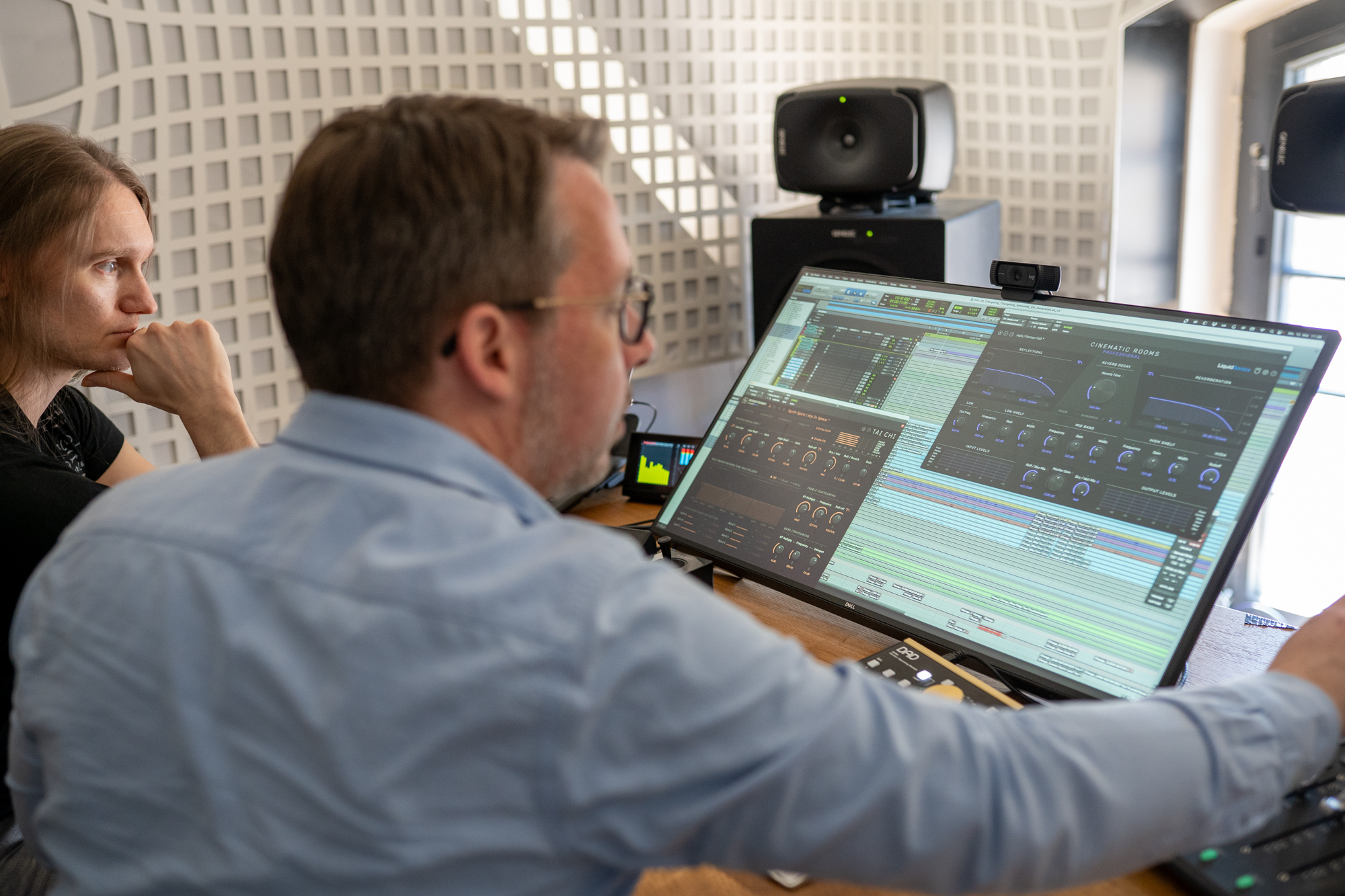
Tom Fountainhead (left) and Eric Horstmann (right) used a range of LiquidSonics reverbs to mix the Changeling project in Atmos.
Q) What drew you to take on a progressive death metal project like Changeling despite your previous focus on electronic music and German rap?
A) First of all, many years ago, I was also playing very hard guitar music. Not metal, but very heavy, new metal stuff. And I thought, okay, heavy guitar music is something that is very difficult in Atmos just by the design of an electric guitar, which can become a pink noise generator when you’re not paying attention in a 3D space. I thought, okay, that’s definitely challenging, and I thought that’s a good reason to give it a shot.
When Tom approached me about doing an Atmos mix of his music, we decided to do a test mix first. We said: “Let’s take one song, try it out, and see what we can do.” During the first meeting I had with Tom, we were listening across all the Apple Music playlists with all the big hits, all the big names in metal, and we went very deep. So, we listened to a lot of recent metal tracks in Atmos that are commercially available, and there was literally no track that made us think, “Wow, that’s an amazing Atmos mix!”
So that’s when Tom said, “Okay, let’s go all in. Let’s forget about stereo completely and just make something new, and hopefully we get into the Dolby Atmos or Spatial Audio metal playlists, and people will hear a huge difference between our mix and what has been there before”. That was the challenge we tried to take on, saying, “Okay, let’s make it big. Let’s make it really big.” The ‘Wall of Sound’ is old school. We need more. We wanted to transform the ‘Wall of Sound’ into a ‘Room of Sound.’ And that’s how it started.
Q) Was this project conceived to be produced and mixed in Dolby Atmos from the beginning?
A) Tom went to a listening session of Rammstein in Dolby Atmos in a movie cinema, and he thought, “Wow, that’s an interesting format. I definitely have to do something in this format with my next album.” Everything in Changeling has been composed with Atmos in mind, but without the technical capabilities or know-how to actually create it at the time. So he found a label that supported the project, Season of Mist, for the metalheads. And so he went on with the stereo project. Everything was finished. And then he found me and said, “Hey, can we do that in Atmos?”
It has been composed and conceived of in Atmos from day one, but he simply didn’t have the capabilities of doing it. So we left the stereo version as it is and decided to go all Atmos, which very quickly had him go back to the studio to re-record all the main guitars, and not only double them, but quadruple-track the guitars or even more for the whole album. It took him probably another six weeks. Tom plays a seven-string fretless guitar, and you can imagine how tuning-intensive this instrument is, when you do that with the required precision for all four quad channels, just to have the guitar structure, plus tons of other stuff.
In the Atmos version, you hear many elements that were not designed for stereo and are not part of the stereo mix, which is great. I think that’s something we have to do for an Atmos mix in this music.
Q) With a 60-minute album featuring a 50-piece ensemble, what was your approach to organising such a dense and complex project for Atmos?
A) We were reviewing the various instrument groups, and we started with the drums. Metal music is very particular about drums. They have to have amazing punch; they need to cut through the guitar massacre and everything that is going on.
We spent a lot of time in the beginning to define the 3D boundaries of the mix. I had 40 drum tracks: every single shell, tom, snare, cymbal, and every little bell and whistle in individual tracks. So we first designed the whole drum kit for 3D playback. We eventually reached the point where we made it quite immersive by pulling out the low toms, toms four and five, very close to your side, and also added numerous room microphones to place them within the room. So when you listen to the drum stem alone, it sounded already super spatial after our first weeks of mixing. The first probably three months we spent just defining how we wanted the immersive mix to sound as a whole, and then we could go on and actually mix the songs. It was a process of figuring out how much 3D, how immersive, we wanted to be.
And then we went on to the guitar group, which is arguably the most important one. Tom went back to record more guitars because “more is more”, and we tried to find a place for all of them. Until one week before our delivery deadline, we were coming up with new ideas for parallel compression and things like that for the whole guitar bed and said, “Okay, cool, that’s great.” As a result, we then went back to all the other sessions using track presets to implement those changes. So we were never really finished with the record until the last day. But I think the result is quite good and absolutely worth the effort.
Even with the guitars, the question is: “How big do you go?” We are all kind of used to a wall of sound with the energy coming from the front, maybe a little bit on the side. But for us, it’s everywhere. All the speakers have full-throttle guitars. All the clean guitars, pad guitars, or ambient guitars are mainly in the ceiling speakers. Everything that is heavy and super aggressive is on the lower speakers. However, we don’t make a distinction between the front and rear, it’s an equal balance. We believe the rears are as important as the fronts for this whole experience.
Then, obviously, on some of the tracks we had a 50-piece orchestra: a massive brass section coming in that needed to cut through the guitar massacre. We are utilising the height channels a lot just to make space.
Q) Where was Changeling recorded?
A) In various great-sounding spaces and places. The drums were recorded in L.A., California. The bass in London. The horn ensemble was recorded at the Carl-Maria-von-Webern University in Dresden, Germany, the trombones were recorded through a remote session in Amsterdam, the church organ at an Evangelical church in the city of Wrexen, and most of the strings and other instruments were recorded at Tom’s home-studio in Berlin. The final song has a massive church organ that obviously comes from the top rear in the mix. We spent a lot of time finding the right place where everything should be so that we can run it at high volume but still not crush it to death.
Q) What strategies did you use to make these different elements come together into a cohesive mix?
A) Placement was the most important factor, and that’s also the big difference to stereo production. In stereo, you would start to filter, to compress, and duck to make things audible. But in Atmos, you can literally just place it somewhere else so it cuts through, hoping that nobody’s listening to it on headphones. The Changeling album has been mixed for speakers 100%. If you want to listen to Changeling on headphones, go with the stereo version. We must be honest about this.
Solving mix problems through placement choices was the goal. We found a pocket for the vocals, and then we had some horns coming, so we said, “Okay, we cannot put them at the same position as the vocals.” So we found a new place for the horns. And then, maybe some world music instruments come in, and maybe we put them in the front but above the vocals. Just try to not let them clash but create a very cohesive 3D image. I think that did the trick.
And reverb played a crucial role here. Yes, we had all the original stems and original reverbs from the stereo production. But because our approach was “Forget the stereo production, we do Atmos now,” we could go all-in on reverbs, delays, and all these kinds of effects as we wished. That’s why we paid close attention to this type of processing and used it extensively.
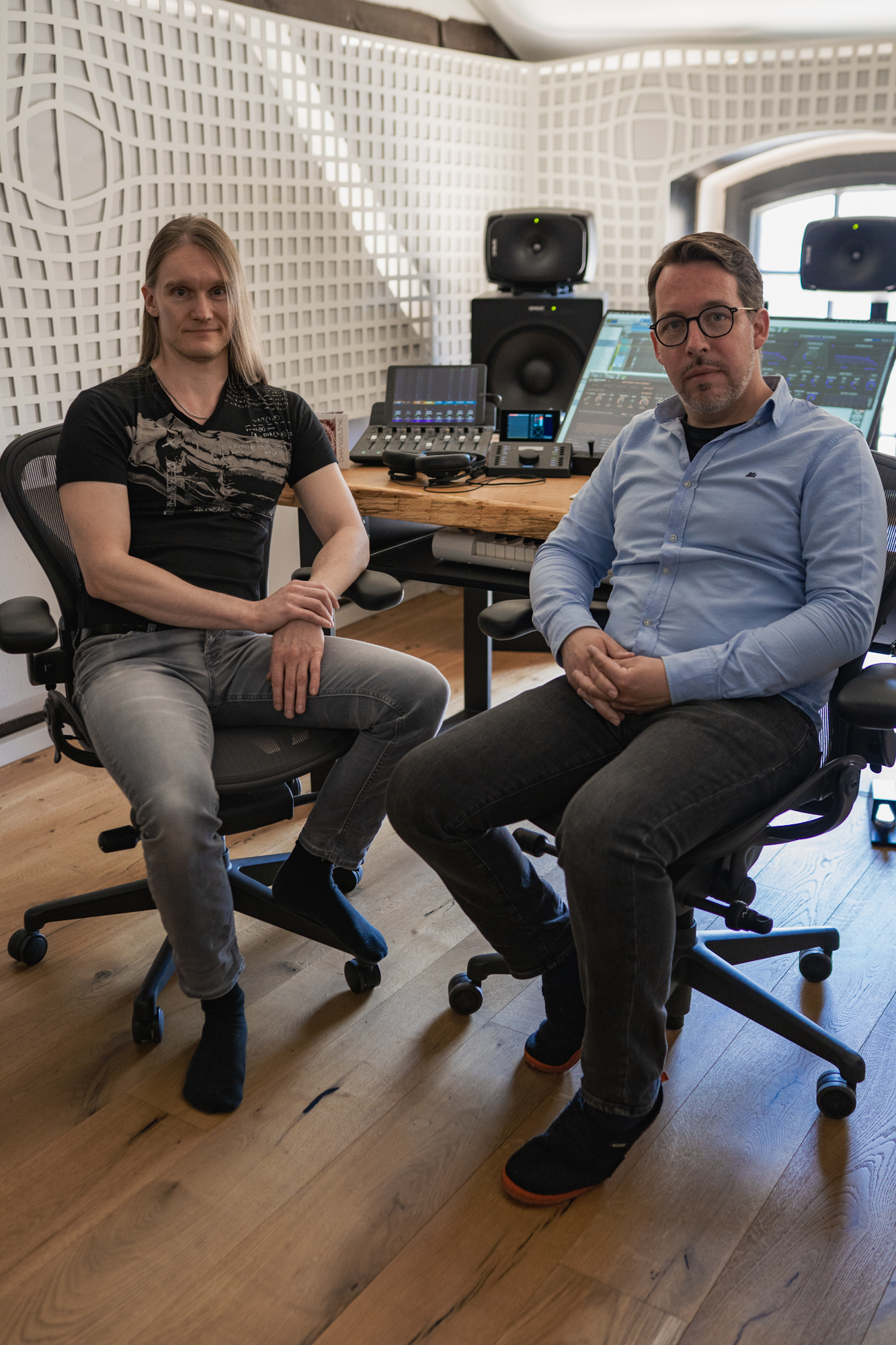

Q) Let’s dive into that: what reverb did you use for the orchestra?
A) My first plugin choice for the orchestra was LiquidSonics’ Tai Chi based on the template I’m using for my electronic music. It’s quite lush and it has a bit of delay. But we had to add another reverb to the Tai Chi, it was the Lustrous Plates Surround, but only parts of the instruments of the orchestra. So let’s say the violins got the additional reverb on top, but not the upright bass. Or the trombones got it but not the trumpets, depending on the frequency range of those instruments. By the way, those are all real instruments; no virtual MIDI instruments. A real recording of a trumpet might sound and might interact with reverb much differently than a pre-recorded MIDI trumpet.
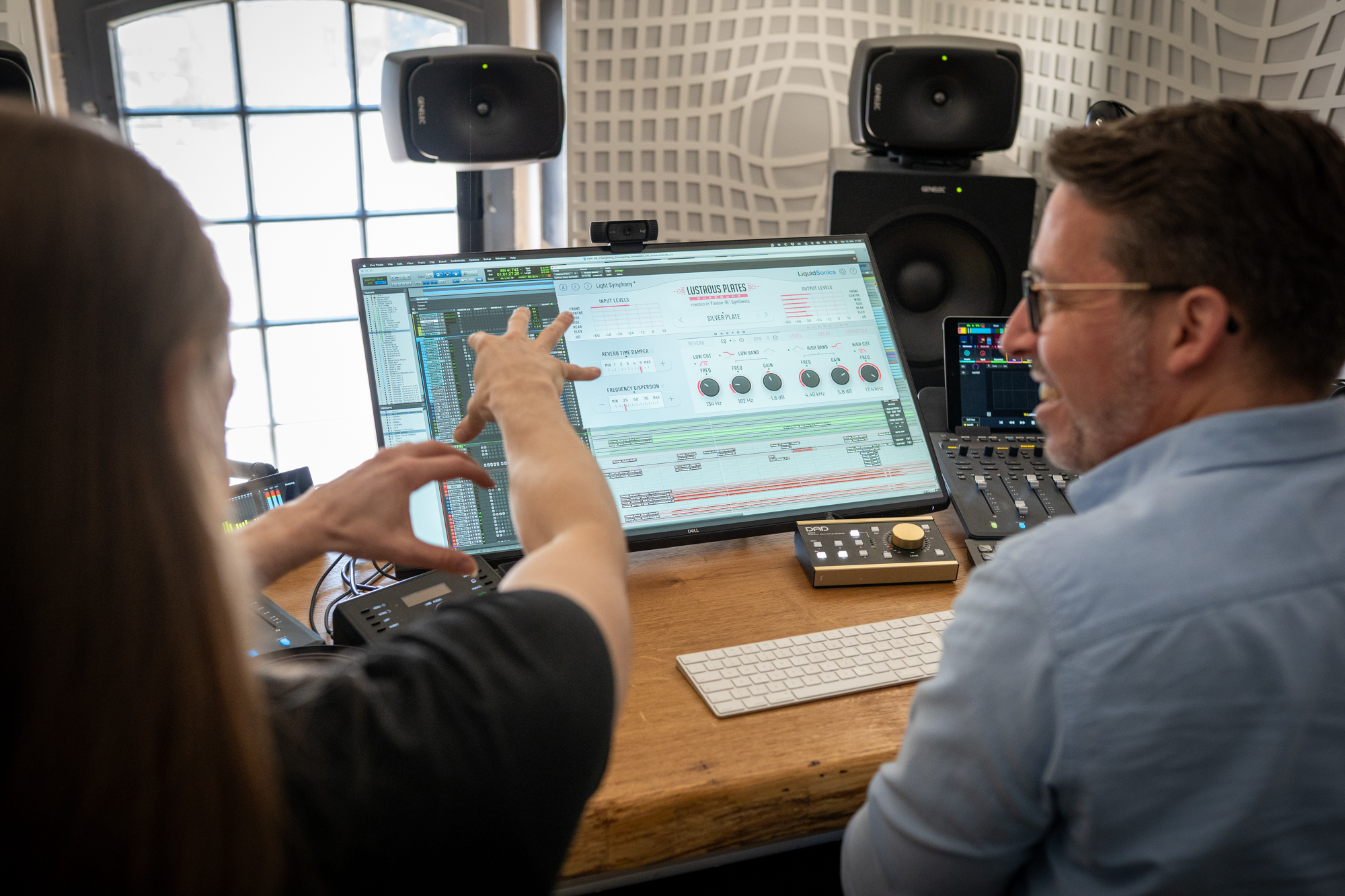
We had some original reverbs from the church where he recorded the orchestra, but we tended to leave those behind and rebuild them with the LiquidSonics plugins, because we had just more flexibility afterwards.
During the mixing process, we decided “hey, these 2-3 reverbs, let’s always use them for orchestral parts”, be it strings, trombones, or the horns, the organ, or whatever. Even choir parts, because we have a lot of choir parts in the album.
Q) What are the similarities and differences between mixing electronic music and metal music in Atmos, particularly regarding clarity?
A) I can’t speak about the stereo world, because I’m not using stereo unless I have to. But in Atmos, there are some specific aspects that are similar, but also some very different considerations. As you said, density is definitely an important point, because when you have five synthesisers, there could also be five distorted guitars. Making them cut through and trying to find their own space and layering – that is definitely a challenge in both metal just like it is electronic music.
The biggest difference between those two genres is that we have a lot more movement in electronic music: automated movement in the songs, at least that’s what I do in my mixes. Whereas with metal stuff, you try to keep it static but immersive, with the exception of small elements that are worth moving in the 3D space. But that can be more distracting at some point. I mean, you can’t move heavy rectifier guitars, because that is just like if you’re panning a pink noise generator, you get instant flanging effects in the room. It doesn’t do the trick.
Q) Both genres require punch despite their density. How do you avoid sacrificing punch for spaciousness when using reverb?
A) I mean, that’s a general challenge in immersive mixing: the punch. Mainly in electronic music and rap, because that’s where you get dismissed instantly when the punch is missing. I think many people are accustomed to the sound of their stereo masters, which are very punchy. At the beginning of my template-building phase, that was the reason why I built my extensive multi-master-fader-saturation-sidechain-mastering chain to keep the punch alive. And it works quite well.
For metal music mixing, it was similar. We were using the same chain, but not as dramatically as I do in electronic music. It was more subtle, but it was the same chain. For metal mixes, we were setting up a lot of parallel compression for certain groups of instruments, mainly for the guitars and for the bass, just to keep this crunchiness, but still preserve the attacks of the guitar and the drums. We had multiple instances of parallel compression in place for 9.1.6 environments. A reason why I keep my reverbs separate in a dedicated object bed is to not involve them in any kind of mastering processing.
Q) Are there certain qualities in the LiquidSonics plugins that make them particularly useful for these genres?
A) I have to be honest with you: I’m not the type of guy who takes five different reverb plugins and listens to them all to analyze “What are the differences between them?” I’m a very emotional mixer, and when I find something that touches me and I say, “Hey, this sounds great, it sounds right as it is,” then I keep on using it. And that was the case with the LiquidSonics reverbs.
The plugins just instantly connected to my workflow and integrated into the structure of my session template, and they happen to sound amazing. As simple as that.
There’s not much I can say about different parameters, because they all have the right parameters. They all sound in some way good and have some unique character. But that’s not the point. For me, it’s all about the feel: it has to feel right, and it has to be appropriate for the song that I’m mixing.
That’s the reason why I have five instances of different LiquidSonics reverb plugins in my template. When I feel like Cinematic Rooms doesn’t work, then let’s switch over to the Lustrous Plates; that might work. And if that doesn’t work, I have Tai Chi available or Illusion. So for me, there’s no reason to look beyond those plugins in my template.
Everything is sitting there and ready to go. None of the plugins are deactivated, they’re all active. I just open the send to the aux track, turn it on and then I hear reverb. That’s my approach to using reverb.
Q) You mentioned getting quite technical with Tom Fountainhead on the Changeling project – can you elaborate?
A) Tom was here with me all the time at the studio, and we spent ages together here. He’s the type of guy, as we say in Germany, who can “hear the grass growing”. He’s really super detail-oriented, and I’m more the big-picture guy. That’s why in film post I was never the sound editor; I was always the re-recording mixer, because I wanted to see the whole arc of the movie and the drama that’s going on. If there was a footstep that had a little click or something: yes, so be it.
Based on my experience with LiquidSonics in electronic music, I started with a preset mostly, but then I tweaked it to my taste in terms of pre-delay, reverb time, EQ; all the basic treatment.
When it felt right, then I left it. When I stop and think “Okay, it doesn’t work at all,” then I might go in and change it, of course. But that’s not me all the time. I tend to concentrate on the big picture.
Q) How does placement in Atmos compare to using surgical EQ in stereo mixing for creating clarity in metal music? Does immersive mixing make it easier?
A) It makes it at least six times more difficult sometimes, because we have two by six speakers! It’s just very different, because as you said, EQ can be very surgical in stereo to make space for elements to fit in. We use sidechain compression, plugins like Wavesfactory Trackspacer, all these tools and tricks to avoid masking. Those things happen in immersive mixing as well, partially because we decide to put more sounds in immersive projects.
So then we have more stuff that is potentially affected by masking, just by deciding to have more main guitars, for instance. Of course, the rear left quad guitars are fighting with whatever is happening in the rear left speaker: reverbs, choir, strings, whatever. So you still do a lot of “track-spacing”, but, interestingly, you do track-spacing per position. We might use a track-spacer for everything that happens in the right side surround, for example. So when we have elements piling up in that moment on that surround channel, then we only have a bit of demasking going on for that particular space.
Of course, you start with placement first. When that doesn’t solve it, then you add some kind of sidechain or track-spacing. But you do that very surgically per element in the room or per placement in the room. We also have a Trackspacer for the rear top surrounds. Just to make a reverb tail cut through a big trombone moment, for example. The fact that these considerations are now spread out across the entire room actually makes it a bit more difficult, I think.
Q) What are your typical reverb approaches for different elements in metal, particularly guitars and vocals?
A) The vocals have a little bit of reverb, but not that much, because I mean, this is not your average singing vocal, it’s mostly shouting. The good thing about not having a lot of reverb on the vocals, is that they actually cut through very nicely and have their own position in the room. We did not restrict them to the left and right channels, we actually pulled them a little bit into the 3D space. The side surrounds get a very subtle amount of the vocals, but it feels like you bring them a bit closer to you, because there are so many guitars happening.
In some parts where the vocals are more melodic and not distorted we use more reverb, which was mainly a combination of a medium hall Cinematic Rooms Professional preset and Lustrous Plates. The drums also got some reverb, mainly to fill the rest of the room beyond where we have positioned the drum shells. So the front part of the room gets very little reverb, but the rear of the room gets more, plus the many room microphones that we have from the original recording. On a couple of songs we created a snare boom reverb with a stereo instance of the Illusion plugin.
We used most of the reverb for the orchestral parts, the synth parts, some piano, and some synth elements. However, the guitars definitely got zero reverb! We were trying to make them even more crunchy and bitey, and then reverb would have been the wrong decision there. The guitars help glue everything together!
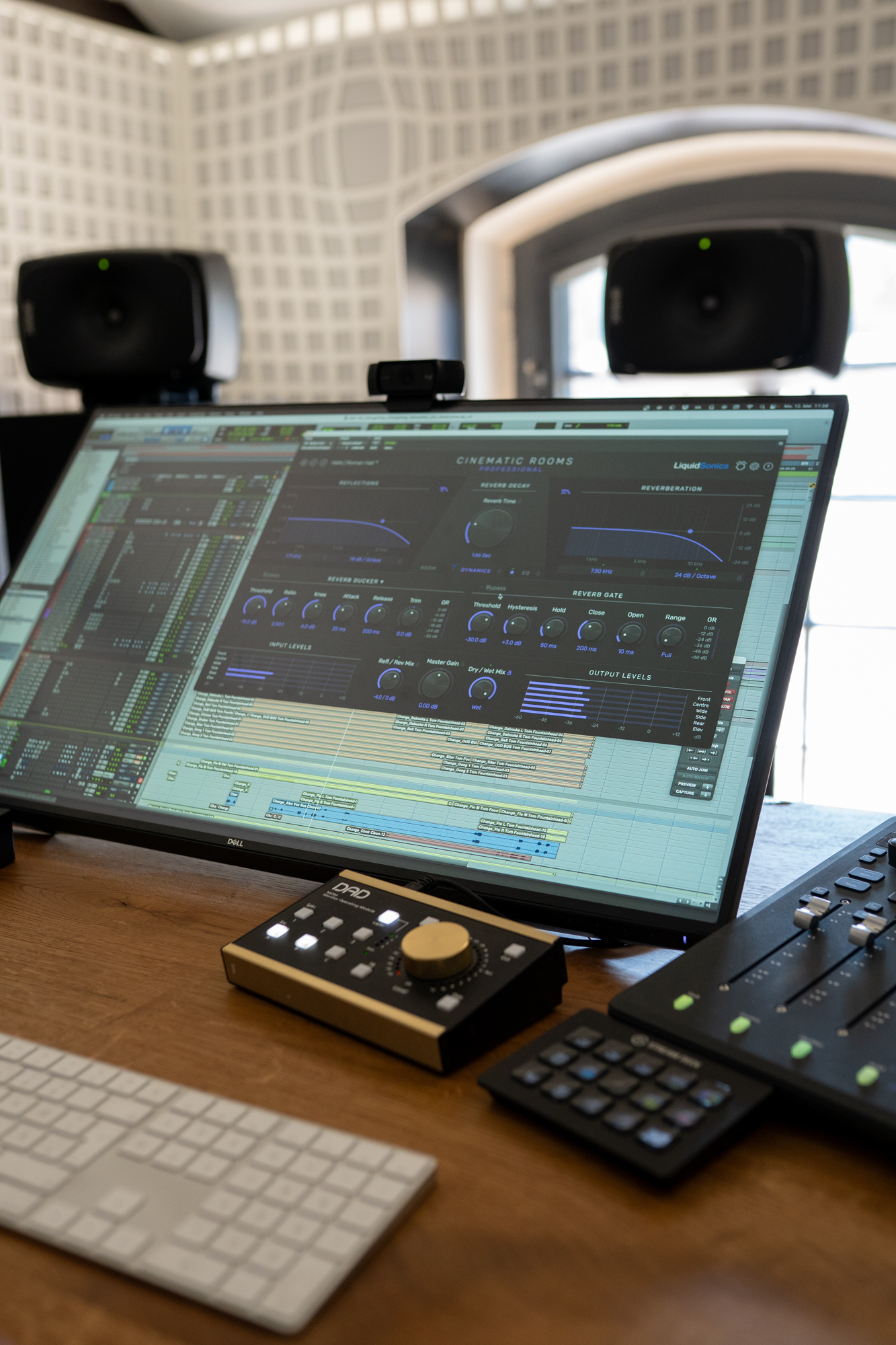
Q) Do you have favourite presets in the LiquidSonics plugins, or do you primarily use your customised template settings?
A) Yeah, it’s all tweaked. But I think for those of the readers who are new to LiquidSonics and need a good starting point, let’s say for Tai Chi, then definitely the “Arp in Space” preset. That’s the one I fell in love with. I don’t know why, but it triggered some emotional reaction in me.
And for Cinematic Rooms, I start by browsing a category, if it’s halls or nonlinear or post rooms, etc. But I mainly stick to the halls category being in music mixing. Obviously, the post and outdoor spaces presets are great for film post. But I do a lot of manual tweaking until it fits and I find my own preset to stay in my template.
I think the golden rule is that it’s never just one reverb that does the trick. It’s always a combination of maybe up to four reverbs. In a particular song, you might use 40% Tai Chi, in the following song, you only use 5%. But then you have 10% more of another reverb, and so on and so forth. That’s also what happened in the Changeling project. Of course, with songs that are up to 17 minutes long, you encounter a lot of different sections in one track. Other people make a whole EP out of 17 minutes of music!
Q) What are your go-to plates in Lustrous Plates?
A) Rhodium plate is my main one and I really like it. The Gold plate is also pretty nice. Those are the two that I use most often. It’s not that the others are not good, but those happened to be the ones I used as starting points for my own presets.

In the room with Tom Fountainhead
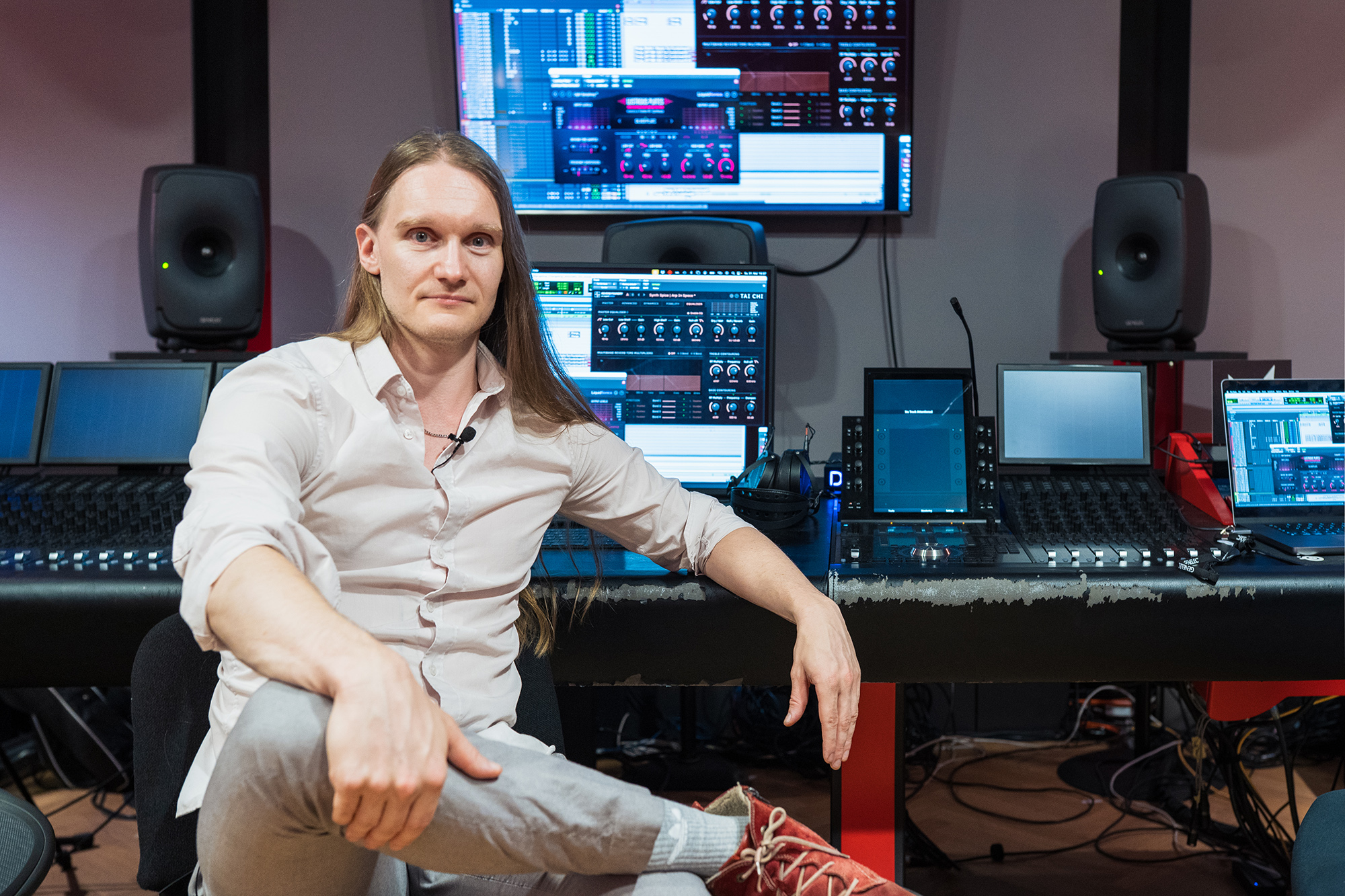
Q) When you initially conceived Changeling for Atmos, what were you looking for sonically that the stereo mix couldn’t provide?
A) I was looking for something in the Atmos mix of Changeling that would basically enable me to start from scratch, just from the dry tracks, and not recreate what I had done in the stereo mix, to immediately feel that openness. Not only the space using the reverb in an immersive setup, but also just an openness in quality.
And when Eric pulled up the Tai Chi, that was my first thought: “Okay, this is the expensive reverb that I had been looking for,” especially for the orchestral instruments in the mix.
What is happening on this album is not a realistic representation of an orchestral ensemble at all, and it was never meant to be.
We were basically in uncharted territory, having orchestral ensembles of up to 50 players, and even those players were often double-, triple-, or quadruple-tracked to have a really lush, giant ensemble. So you have an ensemble, but it’s spread out and it’s doing different things at the same time.
You need to find elements in the mix to connect them, to make them feel as if they’re still part of the same ensemble of people playing together, reacting to each other, even though you are giving them all the space so that each arrangement element is clearly audible on this hyperreal soundstage, if that makes sense.
Obviously, the LiquidSonics plugins were a massive part of that solution, making these elements come together through a shared bed of reverb, creating a unified space. And that was a very specific combination of requirements that was only really coming at me from the speakers when Eric pulled up Tai Chi.
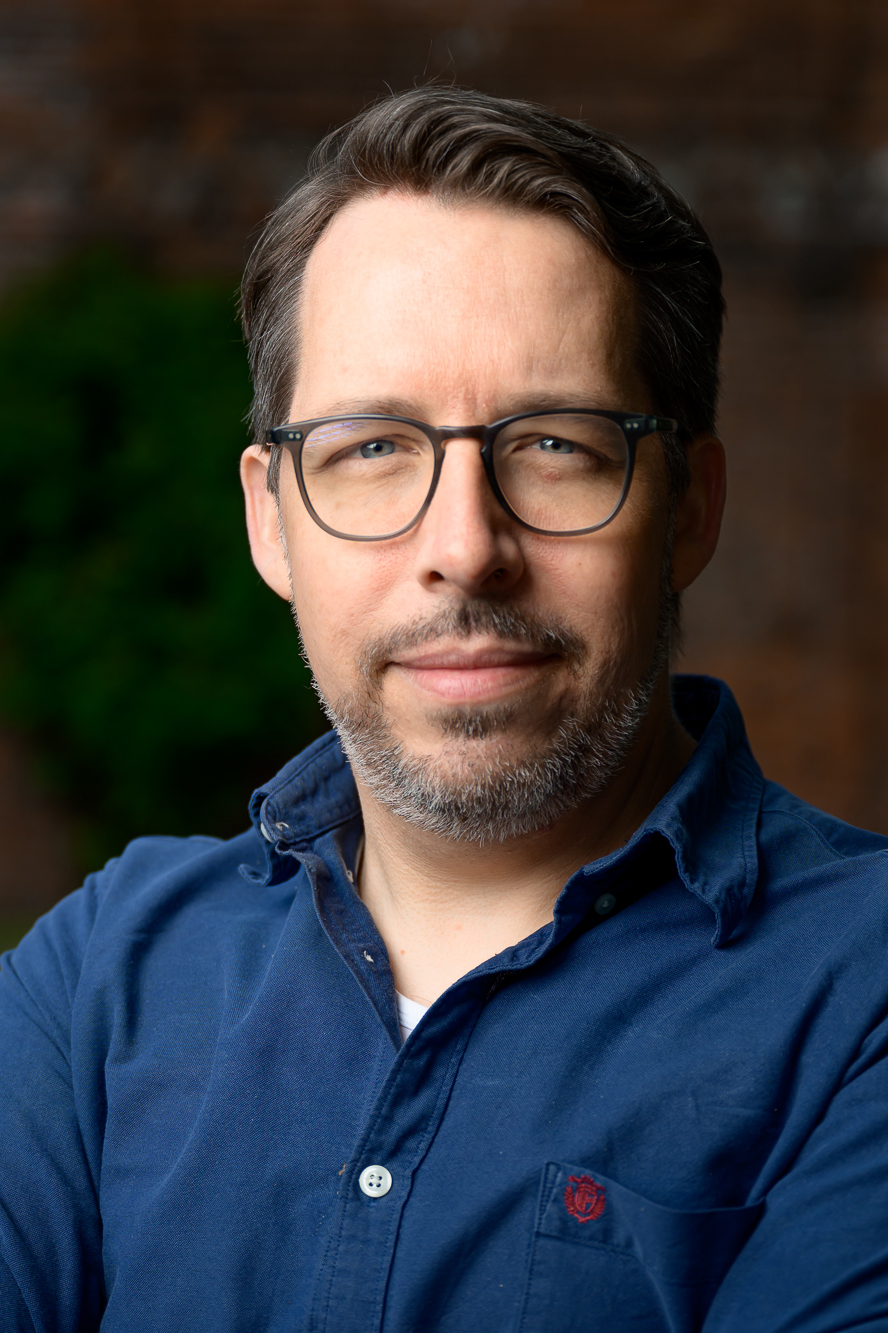
Q) Based on your experience with Changeling, what unique opportunities does Dolby Atmos offer for metal music mixing?
A) I think the biggest opportunity is to make people aware that Atmos is not limited to certain genres. That it can also work for very guitar-heavy, extreme genres when done right. I mean, of course, other people will have to judge the quality of our Atmos mixes, but we are happy with them or we wouldn’t have delivered them. I believe we have proven that Atmos can work for very heavy guitar music, a genre that needs this extra punch and this aggressiveness.
Here’s a little anecdote: last week we were doing public listening sessions of the Changeling album and people said it was the most physical experience of a musical performance or presentation that they ever had, because it has this sheer energy in the entire room.
We had to take two breaks during the playback because people were like “I have to get a cup of water, some air, I don’t know, smoke a cigarette.”
It is so physical, and I think that’s a testament of what we have done with this album. We can better transport emotions than in stereo, and these 80 people who have listened to it can attest to it. So Atmos is amazing for all genres.

Q) How do you approach dynamics and the LFE channel in metal mixes for Atmos, considering the traditionally compressed nature of metal masters?
A) Regarding the LFE channel, it didn’t play a big role at all in the whole album, unless we had some synth, a weird dark atmosphere, in some parts where we needed a bit more of rumble. But it was more of a feeling rather than a discernible sound.
Q) No drums in the LFE?
A) Basically, just very little kick drum.The kick drum is playing 32nd or 64th notes all the time. So there’s no need for an LFE because it would just muddy everything. We also kept the bass guitar out of the LFE because it was just too muddy, and we needed a more punchy sound.
We only used the LFE channel for the church organ, which was super low, because that created some kind of weird tension. It was more of a cinematic approach. Usually, dark metal, death metal, it is cinematic. That’s how these artists compose their music. They have pictures in their mind all the time.
The stories that Tom told me about the pictures he had in his head for the album – actually, it was a movie without picture. And you can transport this concept very well in Atmos compared to a stereo mix.
As for dynamics, we utilise them quite a lot. Tom was very sensitive to dynamics in the stereo master, but in Atmos, obviously, we could really increase the range drastically. There are some parts that are barely audible at the listening level. And then suddenly something kicks in at high volume. We saw that in the reaction of the people at the listening sessions. Everybody was really shocked. And these are reactions that I don’t think you get in stereo, because of the squashed dynamics in the stereo master. Dynamics are a big part of our “non-picture movie” in the Changeling project.
Q) What advice would you give to metal engineers looking to move into immersive mixing?
A) Listen to the Changeling album, and if you still like it, then go ahead! It’s worth a try, and don’t be shy. Be ready to experiment, think outside the box, and keep the stereo as it is. The stereo is great, and it will be used for 100 million playback scenarios, but those who have an Atmos rig can really benefit from an immersive mix version. And don’t mix for headphones. Think of it – you can create a mix that is not made for headphones, that is actually made for a properly calibrated speaker system. Then you can really transport emotions and physical impact.
Q) What production aspects should be considered when planning and producing for an Atmos mix?
A) It depends on the metal subgenre, but sometimes it pays off to record more individual tracks and have them ready to use in the Atmos mix than bussed together to a stereo group. At least that’s what we found out.
We started with a couple of groups of sounds, but after a couple of sessions we realised we need the individual tracks rather than the stems. So we went back to the original multitrack. More is more, and keep all options open for the Atmos mix. You can always sum it together in the Atmos mix as well – it’s no problem to do so if needed. But yeah, and be open to the storytelling in the room. You can have vocals in the rears whispering weird lyrics if you want. It really enhances the whole experience.
Q) Where can people experience the Changeling album in full Atmos?
A) I’m happy to demonstrate it to everybody in person, because we truly believe it needs to be heard on speakers. It has been conceived of and designed for speakers. It will work on headphones as well, of course, and is available on Apple Music.
Tom and I will also present the project at various conventions and events. We want to spread the word and show it to as many people as possible. Anyone is welcome anytime in our Immersive Lab studios here in Berlin.
A huge thanks to Eric Horstmann and Tom “Fountainhead” Geldschläger for sharing their experience and insights into the making of Changeling.
Eric Horstmann’s web and social links:
immersive-lab.com | Facebook | IG | LinkedIn
Tom Fountainhead web and social links:
thefountainhead.de | Facebook | IG | Bandcamp | Merch | YouTube | Spotify
Photography credits:
Eric Horstmann & Tom Fountainhead photography: Sonic Lighthouse
Additional photography: René Löffler
